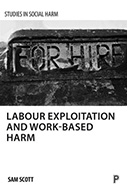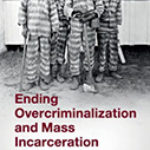Labour Exploitation And Work-Based Harm

Author: Sam Scott
Publisher: Bristol, UK; Chicago, IL; Policy Press, 2017. 297p.
Reviewer: Jon Davies | March 2019
The purpose of Scott’s Labour Exploitation and Work-Based Harm is to argue that labour exploitation and harm in the workplace represent significant challenges to society that dominant capitalist systems are unwilling or unable to fully recognise. Supported by a social harm perspective, Scott emphasises that the political, economic, legal and cultural systems of society frequently cause work-based harm, rather than being an exclusive problem of individual ‘rogue’ employers; and that legal interventions alone are insufficient to address such systemic problems. These points are succinctly discussed through a series of chapters, which include a review of definitional concerns, historical perspectives, key workplace controls that facilitate harm (direct, indirect, and exogenous controls), the problematic notion of worker consent, and importantly, a consideration of how to prevent exploitation and harm in the workplace. A series of thought-provoking poems by Jenny Wrangborg at the start of each chapter introduces the essence of the themes under consideration. The book is based on Scott’s empirical, qualitative research in the UK food industry, which included interviews with migrant workers and key industry figures.
The key theoretical debate referred to in the book includes the tensions between crime and criminology on the one hand, and social harm or ‘zemiology’ (the study of harm) on the other. Scott argues that aside from the most severe instances of labour exploitation where individual perpetrators are easily identified, criminology is limited in discussing ‘grey areas’ of exploitation that are not necessarily criminalised by existing criminal-legal frameworks. In doing so, he calls for a broader approach towards understanding labour exploitation and harm, rather than just the direct, intentional and interpersonal violence that arguably dominates criminological research.
These perceived limitations of criminology get to the heart of why some critical criminologists have argued for ‘abandoning’ criminology in favour of a social harm discipline, so that indirect, ‘unintentional’ and structural features of society may take a more central role in explaining harm. Indeed, this book forms part of a series (Studies in Social Harm) in which the social harm agenda is developed. There have been recent efforts to set out and even reconcile criminological and social harm perspectives (Boukli and Kotzé, 2018), but these tensions remain subject to debate and increasingly seem to represent a fault line between the two disciplines, especially for those researching state-corporate, white collar and organisational crimes. While Scott’s book does not set out to resolve such debates, he makes a compelling case for bringing the examination of labour exploitation within the remit of a social harm perspective. To this end, Scott challenges narrow legal definitions of severe exploitation, as well as the Marxist ‘omnipresence’ of exploitation, by defining labour exploitation as a product of excessive workplace controls.
Arguably, the dynamics between labour exploitation and harm (in the workplace) could have been examined a little more explicitly. In other words, some discussion of whether all harm is exploitative, and perhaps more controversially, whether all exploitation is harmful, may have helped to strengthen the theoretical framework. With the former, there are numerous workplace actions and omissions perpetrated by individuals and organisations that could be considered harmful (e.g. actions resulting in oil spills, money laundering, safety breaches), but these would not necessarily cross over into labour exploitation. For instance, workplace harassment between workers may result in psychological and physical harm – what Scott terms ‘individual harm’, but could this justifiably be classed as labour exploitation?
With the latter, especially regarding migrant labourers, there is an argument that workers may consider themselves to be relatively better off (financially and vis-à-vis their longer-term goals) in exploitative work as opposed to having no work at all, or work that they would otherwise occupy in their home countries. Workers may view exploitation as a ‘stepping stone’ and tolerate such conditions in the expectation that they will eventually lead to ‘decent work’. In such circumstances, to what extent can exploitation be considered harmful if workers seem to be better off in relative terms? Others refer to the notion of ‘net harms’ in order to consider similar issues. This is not to suggest that all potential harms could or should be quantified; nor is it intended to detract from individual experiences of mistreatment. However, given the emphasis that social harm places on harms occurring during the life cycle, to what extent could such examples be considered harmful when compared to other workers who were unable to progress and so remain trapped in exploitative work? This discussion is implicit within the book, but drawing out these issues might have been helpful in order to further develop the social harm perspective.
On the theoretical basis of social harm, Scott proceeds to move beyond notions of ‘crime’ and severe practices typically associated with labour exploitation, including modern slavery, human trafficking and forced labour. He does this by drawing on a labour exploitation continuum, which has grounding in previous work on this subject. Specifically, processes including deaths in the workplace, chattel slavery and forms of severe (criminalised) exploitation are discussed as one extreme end of such a continuum. These occur alongside ‘less severe’ actions or omissions on the other extreme, that are unlikely to be classed as breaches of criminal law, but which may occur as violations of administrative, civil, labour or regulatory law – or even beyond the scope of legal intervention entirely.
Hence, the book gets to the heart of Scott’s argument, and develops labour exploitation and harm as a product of excessive work-based control, consisting of direct, indirect, and exogenous controls. These factors, in relation to prior research on corporate and organisational crime, seem to be implicitly framed as occurring at the interpersonal (micro), organisational (meso), and societal (macro) levels respectively.
According to Scott, key features associated with direct controls include factors such as excessive work hours, meeting strict targets, heavy surveillance of toilet and rest breaks, as well as docking of pay if certain targets are not met. Many of these practices occur due to control from employers and managers. He acknowledges that some level of control in the workplace is necessary and arguably helpful to some extent. However, these excessive controls under consideration are designed to encourage ‘better workers’ who, when coupled with the threat of job insecurity, are more grateful for employment opportunities, so are likely to work without being coerced and without significantly challenging exploitative conditions. From a social harm perspective, the impacts on workers’ physical and mental health, among other factors, are of concern here, along with whether the workplace control that results in these harms is excessive or even oppressive. It is here that the boundaries between ‘decent work’ and the beginnings of labour abuse are less clear cut, yet the framing of excessive control helps to bridge this gap.
Regarding indirect controls at the organisational level, a stronger degree of subtlety is applicable, since according to Scott, these controls are ‘as likely to be felt as to be seen’ (p99). A classic example is the role of labour intermediaries, who may employ workers and supply them to businesses on a casual basis, which makes it harder for workers to challenge those responsible for facilitating exploitation and harm. A diffusion of corporate responsibility may result, which interlinks with the overall development of deviant corporate cultures and decision making. For individual workers, let alone outside actors, understanding such processes may be a highly complex task, which contributes to a veil of secrecy regarding the more elusive ways in which organisations control their workers.
Exogenous controls are framed as largely occurring beyond the workplace; although they can clearly have impacts within the workplace. Scott points to the gradual shift in employment relations and changes in the labour market that have resulted in job-related insecurity for workers. At the same time, political-legal contexts including immigration regimes, state regulation of markets, and inequality contribute to how people may perform in the workplace. For example, distinctions between citizenship and migrant statuses result in latter groups having limited access to some forms of social protection, despite many states being dependent on migrant workers in many of their economic sectors. In conjunction with direct and indirect controls, these exogenous controls are essential in order to develop a comprehensive view of how exploitation and harm occurs.
Having established forms of workplace control, Scott addresses an underlying thread in his discussion that not all exploitation is coercive. Instead, the notion of ‘consent’ is problematised, ranging from coercion to informed consent, with numerous forms of deception and worker toleration in between. Aside from perhaps the most severe cases, a significant amount of labour exploitation does not have coercion or force associated with it. There seems to be a ‘continuum of consent’ that integrates closely with the labour exploitation continuum discussed in this book – although this idea is not explicitly discussed here. Importantly, however, a key assertion is made that while workers may make choices within limited options, they are frequently doing so as a way to pursue the least bad option for themselves, which may include tolerating some form of workplace exploitation and harm.
Crucially, Scott considers how best to prevent exploitative and harmful practices from occurring in future. In keeping with the argument that legal remedies for (severe) labour exploitation are limited, a range of intervention points are discussed, including labour inspection regimes, trade unionisation, and broader social movements. Rather than rehashing the well-trodden debates of whether direct state intervention or ‘corporate social responsibility’ works as a more effective model of oversight, these alternative approaches provide useful lenses through which to consider remedial action and, presumably as a long-term goal, to reduce harm in the workplace. There is little coverage of ‘Brexit’ as part of the discussion on future directions – although this is arguably an advantage for the book’s purposes, since it means that the discussion remains focused on labour conditions, workplace processes, and systemic factors that lead to exploitation. Due to the continually evolving factors related to Brexit, any consideration of these would likely be speculative at best, and importantly for the book, would distract from the central argument of how exploitation and harm results from societal structures.
Ultimately, Scott’s Labour Exploitation and Work-Based Harm helps to reshape some common (mis)understandings of labour exploitation, and more broadly, harm in the workplace. It is a wide-ranging yet informative text for those who are interested in key features, processes and oversight of these areas. The themes explored in this book will be important reference points in future research across a range of disciplines, especially given the increasing emphasis that researchers, policy makers and the public are placing on ‘modern slavery’ and labour exploitation.
References
Boukli, A., and Kotzé, J. (eds.) (2018) Zemiology – Reconnecting Crime and Social Harm. Palgrave Macmillan.
Reviewed by Dr. Jon Davies, Research Fellow, Faculty of Law, Tel Aviv University


